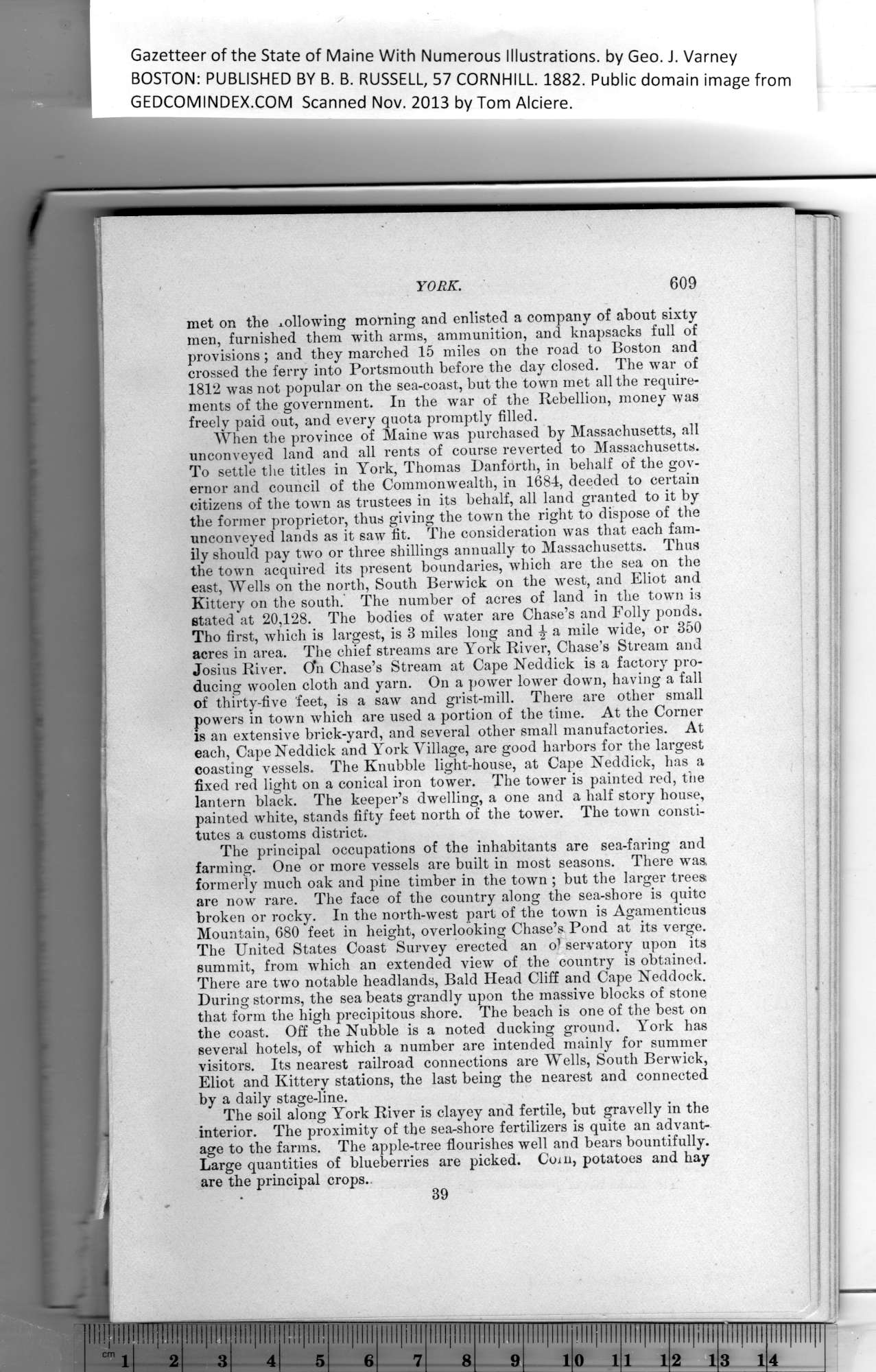|
Gazetteer of the State of Maine With Numerous Illustrations, by Geo. J. Varney
BOSTON: PUBLISHED BY B. B. RUSSELL, 57 CORNHILL. 1882. Public domain image from
YORK. 609
met on the mllowing morning and enlisted a company of ahout sixty
men, furnished them with arms, ammunition, and knapsacks full of
provisions; and they marched 15 miles on the road to Boston and
crossed the ferry into Portsmouth before the day closed. The war of
1812 was not popular on the sea-coast, but the town met all the require-
ments of the government. In the war of the Rebellion, money was
freely paid out, and every quota promptly filled.
When the province of Maine was purchased by Massachusetts, all
unconveyed land and all rents of course reverted to Massachusetts.
To settle the titles in York, Thomas Danforth, in behalf of the gov-
ernor and council of the Commonwealth, in 1684, deeded to certain
eitizens of the town as trustees in its behalf, all land granted to it by
tbe former proprietor, thus giving the town the right to dispose of the
unconveyed lands as it saw fit. The consideration was that each fam-
ily should pay two or three shillings annually to Massachusetts. Thus
the town acquired its present boundaries, which are the sea on the
east, Wells on the north, South Berwick on the west, and Eliot and
Kittery on the south. The number of acres of land in the town is
stated at 20,128. The bodies of water are Chase’s and Folly ponds.
Tho first, which is largest, is 3 miles long and £ a mile wide, or 350
acres in area. The chief streams are York River, Chase’s Stream and
Josius River. On Chase’s Stream at Cape Neddick is a factory pro-
ducing woolen cloth and yarn. On a power lower down, having a fall
of thirty-five feet, is a saw and grist-mill. There are other small
powers in town which are used a portion of the time. At the Corner
is an extensive brick-yard, and several other small manufactories. At
each, Cape Neddick and York Village, are good harbors for the largest
coasting vessels. The Knubble light-house, at Cape Neddick, has a
fixed red light on a conical iron tower. The tower is painted red, the
lantern black. The keeper’s dwelling, a one and a half story house,
painted white, stands fifty feet north of the tower. The town consti-
tutes a customs district.
The principal occupations of the inhabitants are sea-faring and
farming. One or more vessels are built in most seasons. There was
formerly much oak and pine timber in the town ; but the larger trees;
are now rare. The face of the country along the sea-sbore is quite
broken or rocky. In the north-west part of the town is Agamenticus
Mountain, 680 feet in height, overlooking Chase’s Pond at its verge.
The United States Coast Survey erected an o1 servatory upon its
summit, from which an extended view of the country is obtained.
There are two notable headlands, Bald Head Cliff and Cape Neddock.
During storms, the sea beats grandly upon the massive blocks of stone
that form the high precipitous shore. The beach is one of the best on
the coast. Off the Nubble is a noted ducking ground. York has
several hotels, of which a number are intended mainly for summer
visitors. Its nearest railroad connections are Wells, South Berwick,
Eliot and Kittery stations, the last being the nearest and connected
by a daily stage-line.
The soil along York River is clayey and fertile, but gravelly in the
interior. The proximity of the sea-shore fertilizers is quite an advant-
age to the farms. The apple-tree flourishes well and bears bountifully.
Large quantities of blueberries are picked. Com, potatoes and hay
are the principal crops.
39
PREVIOUS PAGE ... NEXT PAGE
This page was written in HTML using a program written in Python 3.2
|
